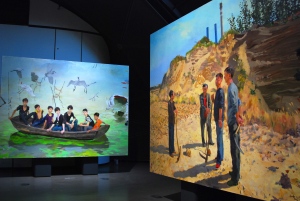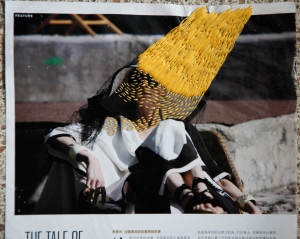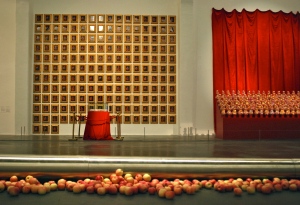Over the years, the future direction of contemporary Chinese art has been scrutinized; the country’s rampant development and overarching tendency towards western mimicry has challenged Chinese artists to establish a clear identity founded within their own cultural traditions and current, youth generation. Curated by CAFA’s chairman and linguistic installation artist, Xu Bing, along side the Guggenheim’s Asian art curator, Alexandra Munroe, CAFAM Future – Sub-Phenomena: Report on the State of Chinese Young Art seeks to explore six, modern phenomena that emerging Chinese artists must face and overcome for the stylistic and conceptual evolution of their work, and additionally dialogue in which their ideas takes place.
Sculptural Installation in Museum’s Atrium
These phenomena, namely, Rampant Growth, Self-Media, Micro-Resistance, Otaku Space, Shallow Life and Unknown, allow for a wide breadth of works that are representative of China’s youth. The exhibition’s large spectrum of media ranges, with works by the video artists Fang Lu, who explores both consumption and beauty in her film Rotten, to Ma Ke’s conceptual investigation of visual image through linguistic illustration, as he covers the surface of 10 large panels with handwritten descriptions of Mark’s Left Index Finger. Yet the incorporation of these six sub-themes renders the exhibition, which fills the museum in its entirety, challenging in phenomena navigation and overwhelming in both physical space and amount of works to process. It was as if the curators intended a seventh phenomenon, Mass Production, in which sustenance, information and that of a more material realm bombard the artists’ environment, rendering it difficult to organize and thus further develop logical thought.
Video Still from Fang Lu’s ‘Rotten’
Detail from Ma Ke’s ‘Mark’s Left Index Finger’
Regardless, this representative survey of young Chinese artists and notions that they encounter and incorporate into their personal dialogue has added a considerable dent into the continued conversation of the future of contemporary art in China.
‘Transforming Life into Art’ by Gao Xiang Fa
‘Crystal City No. 001’ by Wu Chi-Tsung
‘One Bed Room’ by Jiao Meng
‘The Elephant No. 1’ by Zhang YiFan
Another work from ‘The Elephant No. 1’ by Zhang YiFan
‘Four Kinds of Grey’ by Xie Molin, Oil on Silk
Detail of ‘Transparent Monument’ by Ni Youyu
Installation View, Including ‘Transparent Monument’ by Ni Youyu (Left)

















































































